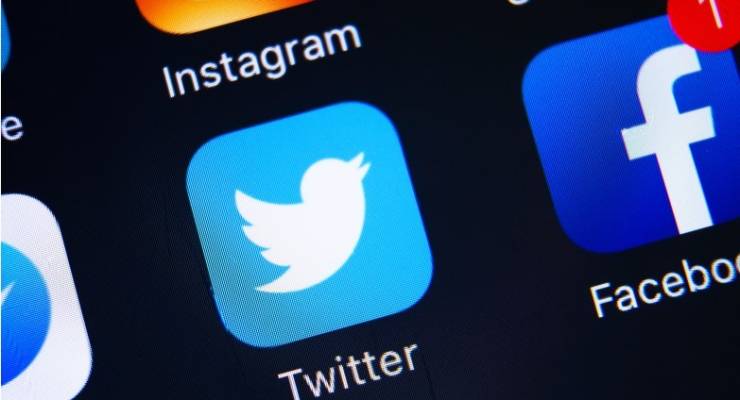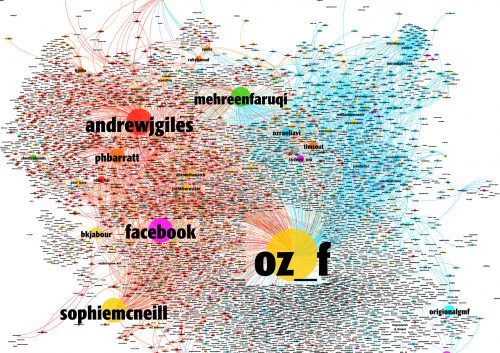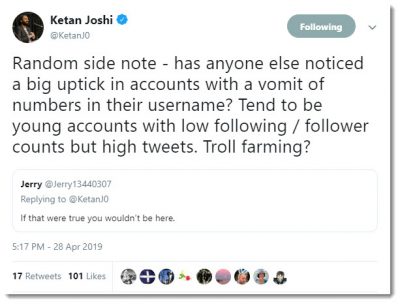
Conventional wisdom dictates that social media has coarsened public debate.
Of course, the idea that Australia’s public debate had a golden age of civility looks quaint if you’ve ever seen crowds booing at a prime minister at a major sporting event, or heard a pub full of half-cut blokes roar “geddoff ya mug” at a politician on TV. But the belief is pervasive among Australian journalists, as was aptly captured by the ABC’s Michael Rowland a few weeks ago, so it’s worth taking a proper look.
Let’s accept that journalists are receiving a greater number of abusive tweets than they were five years ago. Who is operating the Twitter accounts sending the abuse? When Chris Uhlmann says Twitter is infested with “hyper-partisan tools”, is he accidentally identifying another problem: that tweets are, in fact, coming from machines rather than real humans?
After Cambridge Analytica and Russia’s Internet Research Agency, there’s certainly precedent. Such trolling hasn’t historically been a noticeable feature of Australian politics but if it’s changing, one visible symptom would be noise and abuse coming from inauthentic accounts. Some people think they’ve detected just such a rise. Here’s a question posed by science communicator Ketan Joshi:
When I posed the same question to my own followers, a small but steady stream of replies answered “yes”. And interestingly, some of the tweets from Michael Rowland’s article were cited as evidence of organisational (rather than individual) incivility.
If that’s the case, we can all (journalists included) make our social media feeds nicer if we weed out the trolls, fakes, and sockpuppets. So what characterises these accounts? Trent Yarwood of non-aligned digital think tank Futurewise told Crikey organised abuse tends to come from Twitter profiles which:
- Are new; often only a few days old
- Have few followers
- Only follow a very small number of others
- Have “dodgy usernames”, often ending in a long string of numbers (someone auto-registering accounts with a script often doesn’t take time to change their automatically-assigned ID)
- Have extremely repetitive posts
- Often use stock photos as their profile pics (sometimes including the library’s watermark).
Why go trolling?
Dr Michael Jensen, senior research fellow at the Institute for Governance and Policy Analysis at the University of Canberra, tells Crikey these kind of inauthentic accounts are often trying to destroy the consensus needed to govern a society. Jensen has studied “Russian troll” influence in Australian politics, and last year co-authored a piece about this for The Conversation.
As part of that kind of operation, machine-operated accounts (“bots”, run by software scripts rather than humans) are there to flood a conversation with talking points and hashtags. They mostly target Twitter’s “trending topics”, with a secondary purpose to gather followers later subjected to more targeted messaging.
One campaign in 2014 and 2015, he said, used accounts tweeting nothing but Radiohead lyrics to gather followers. It’s a technique of spycraft, Jensen said. “First: show as neutral or benign, before you move your audience to more political themes.”
Even if the influence in Australia is less than in the US, Jensen says those running these accounts share the same goal: “polarisation to undermine the governing capacity of the country”. And that’s where the standing of the media matters.
Widespread campaigns to undermine faith in journalism are more likely to come from fake accounts presented as both “left” and “right”. That way, Jensen explained, a message becomes more familiar to more people and, over time, more accepted.
Looking for the all-Australian bot
However, it’s not clear that “bot” operations are deployed in number into Australia’s Twitter debates. Dr David Spencer, a lecturer at the University of Canberra who has spent months pulling his queries of Twitter’s API (application programming interface) into analytical tools, believes the message-storms Rowland wrote about emanate from political cliques of mostly real, if anonymous, Australians.
International operations do take an interest in Australia, but not to skew politics. Their interest is much darker: to spread abusive pile-ons of prominent Muslim Australians like Osman Faruqi, his mother Greens senator Mehreen Faruqi, or Yassmin Abdel-Magied.
The pile-ons start small, usually with just a handful of accounts, but as the visualisation below shows, it can quickly reach a huge scale.

There are, he said, accounts which “do nothing but pick up a story about Muslims, so it gets circulated everywhere … That brings in very large networks, which means there are now thousands of tweets attacking someone”.
The accounts that kick off international pile-ons are anonymous, Spencer said. “They’ve never done anything except malicious attacks. They tend not to have many followers … but what’s significant is that they get picked up by an international network, so it gets circulated everywhere. There are now thousands of tweets attacking someone — it’s malicious and it’s designed to hurt rather than to change the narrative”.
Locally, what Rowland wrote about is more attributable to a combination of “highly motivated individuals” of one political stripe or another, amplified by a handful of “sockpuppets” rather than bots. “Sockpuppets” are anonymous or pseudonymous accounts run by individuals (often with a party affiliation).
When Patricia Karvelas read a text message from Barnaby Joyce on-air during Insiders, there was a storm of criticism as illustrated by Spencer in the visualisation below.
The colour might suggest a left wing bias in Australia’s Twitter. Spencer offered a hypothesis to explain that: the ALP has learned greater sophistication and discipline than the right-leaning side of Australian Twitter.
Labor has a core of committed individuals following key party accounts, letting an attack spread quickly without help from bots. “It’s impressive, in political terms,” Spencer added. “They’ve laid the groundwork using their membership over years, to have a substantial presence in Australian Twitter.”
He suggested that “Liberal-associated” accounts are less impressive, because that side of politics has fractured since Malcolm Turnbull was deposed from the Liberal leadership in 2017, and social media unity has suffered accordingly. Some accounts that shared links supporting Malcolm Turnbull before the leadership spill still haven’t returned to the fold to support Scott Morrison’s election campaign. Anyhow, he said, Australia’s right-wing Twitter is “more about Mark Latham or One Nation than it is about ‘ScoMo’”.









Wow, talk about a rhetorical question. I’ve come across more sock puppets than I care to mention, almost entirely on the Climate Change Denial/Liberal Party side of the political spectrum.
How many of these amateur trolls are paid to push their politics and ideology for a living – like the professionals in the media, giving a lead?
…… Are the “responsible” media doing anything to pull them into line : or paying them?
Seriously? “Moderation” FFS?
Never used twitter, but are journalists getting more abuse? I can’t find an answer here.
If they are and if they’re working for the 9/murdoch/7/newAbc/guardAu, they should take it up with their owners for antagonizing us, the ones with the turds and tomatoes.
An interesting topic but I couldn’t understand the visuals. There is nothing new about one-eyed party hacks but the speed & extent of coverage is going to become a permanent feature of the political landscape.
Is this just another whining article by the media types? You love the argy bargy of hard nosed opinion giving but fold like a packet of crackers when people give theirs.